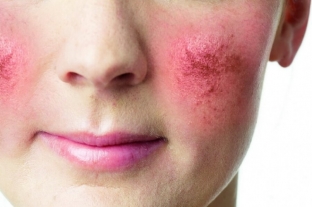The problem of rosacea disease treatment is relevant for clinical dermatology and cosmetology. Rosacea – angioedema with a predominant lesion of the vessels of the central part of the face, which leads to persistent erythema, and in the future – to hyperplasia of the sebaceous glands and inflammation.
The first signs of the disease appear at the age of 25-40 years, and the full clinical picture is formed by the age of 40-50. Women get sick more often than men. Rosacea occurs in representatives of all races, but predominantly – in fair-skinned people. The English call rosacea "the tides of the Celts". How to take care of your skin with rosacea?
Causes, symptoms and stages of development of rosacea
The debut of rosacea is usually liquid tidal erythema, which is caused by numerous non-specific stimulating factors, such as mechanical skin irritation, insolation, temperature fluctuations, hot drinks, spicy food, alcohol. Localization of erythema is most often limited to the nasolabial area.
With frequent relapses, the process can continue for quite a long time, sometimes for years. How to take care of your skin at this time, read further on estet-portal.com. Gradually, moderate infiltration, telangiectasias appear at the site of hyperemia. Erythema acquires a cyanotic hue, can spread to the forehead and chin. Then, against the background of diffuse thickening of the skin, papules appear, first single, and soon – grouped. Later, most of the papules turn into papulo-pustules and pustules with sterile contents. The appearance of gram-negative microorganisms in pustules indicates the transition of the disease to a more severe form. Sometimes rosacea can begin with inflammation of the eyes. There are 4 stages of the development of the disease.
Stages of rosacea disease:
• erythematous - characterized by changes in small vessels – telangiectasia;
• erythematous-papular;
• papulo-pustular - in the dermis, foci of infiltrates and hyperplasia of the sebaceous glands are detected;
• nodular (or rhinophyma) - an increase in sclerosis and significant hyperelastosis.

The main stages of skin care during the rehabilitation period for rosacea
During the treatment and rehabilitation of rosacea products containing substances with aggressive surfactants, microabrasives and scrubs are categorically excluded. In the treatment of rosacea, even active creams should be abandoned for a while, since the disorganization of an already damaged barrier can lead to a torpid development of hypersensitivity. It is necessary to use means to restore the broken epidermal barrier.
Strengthening of skin vessels should begin with the elimination of lymph stagnation and skin detoxification. Lymphatic drainage procedures improve microcirculation and eliminate tissue hypoxia. Lymphatic drainage can be carried out manually or by hardware methods: ultrasonic lymphatic drainage or microcurrents. During this period, it is already possible to do face cleansing: enzyme, ultrasound, gommage.
Cleansing after rosacea is rarely done, once every 2-3 months if necessary, so as not to provoke a relapse of the disease. All professional procedures are carried out using preparations containing moisturizing ingredients, antioxidants and vasoprotectors.
Any facial peels (negative stimulation) are strictly excluded. Tonic preparations with acidic pH (negative stimulation) are completely excluded.
Positive stimulation methods are gradually and carefully connected, since sensitive skin after rosacea may "resist"; any invasion:
- it is preferable to start positive stimulation with surface (nappage) mesotherapy with minimal vascular trauma 1 time in 2 weeks, 3–4 procedures per course;
- it is better to use homeopathic preparations with lymphatic drainage and reparative effects (cutis compositum, lymphomiazot, funiculus compositum, ubiquinone, psorinoheel, etc.);
- after a course of surface mesotherapy, you can start biorevitalization with unmodified hyaluronic acid in combination with sodium succinate (succinic acid salt). This tool can become the support that will allow you to restore not only nonspecific resistance, but also the immune status of the skin during the rehabilitation period after rosacea. The procedure is carried out with very small papules (0.1-0.2 cm) 1 time in 2 weeks, 4 procedures per course.
After 2–3 months of skin rehabilitation after rosacea, in the absence of a recurrence of the disease, it is possible to use such cosmetic techniques as the introduction of botulinum toxin and fillers. For the prevention of relapses, we recommend conducting preventive courses of treatment of diseases of the digestive tract and hepatobiliary system 2 times a year.
Coagulation of blood vessels on the face (laser or photocoagulation) is possible no earlier than after 2 years in the absence of recurrence of the disease.
Thus, the use of a comprehensive scientifically based treatment of rosacea, based on the results of scientific achievements, allows to achieve a long-term remission of the disease with a good cosmetic effect.
Timely, correct and comprehensive treatment of rosacea disease will return the skin to a beautiful and healthy appearance.







Add a comment